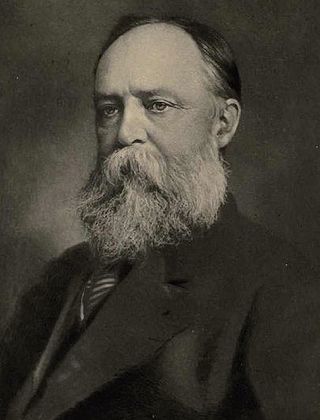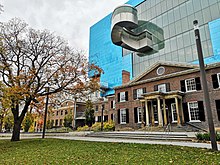
Cobourg is a town in the Canadian province of Ontario, located in Southern Ontario 95 km (59 mi) east of Toronto and 62 km (39 mi) east of Oshawa. It is the largest town in and seat of Northumberland County. Its nearest neighbour is Port Hope, 7 km (4 mi) to the west. It is located along Highway 401 and the former Highway 2. To the south, Cobourg borders Lake Ontario. To the north, east and west, it is surrounded by Hamilton Township.

The Art Gallery of Ontario is an art museum in Toronto, Ontario, Canada, located in the Grange Park neighbourhood of downtown Toronto, on Dundas Street West. The building complex takes up 45,000 square metres (480,000 sq ft) of physical space, making it one of the largest art museums in North America and the second-largest art museum in Toronto, after the Royal Ontario Museum. In addition to exhibition spaces, the museum also houses an artist-in-residence office and studio, dining facilities, event spaces, gift shop, library and archives, theatre and lecture hall, research centre, and a workshop.

Osgoode Hall is a landmark building in downtown Toronto, Ontario, Canada. The original 2+1⁄2-storey building was started in 1829 and finished in 1832 from a design by John Ewart and William Warren Baldwin. The structure is named for William Osgoode, the first Chief Justice of Upper Canada.
Avrom Isaacs, D.F.A. was a Canadian art dealer.

Grange Park is a prominent and well-used public park in downtown Toronto, Ontario in Canada. It is located south of the Art Gallery of Ontario, next to the Ontario College of Art and Design University (OCADU) and north of University Settlement House, at the north end of John Street. The Park lends its name to the Grange Park neighbourhood in the vicinity of the park. Historically, the park was the backyard of The Grange, a manor that was later expanded and became the Art Gallery of Ontario.

The Bytown Museum is a museum in Ottawa located in the Colonel By Valley at the Ottawa Locks of the Rideau Canal at the Ottawa River, just below Parliament Hill. Housed in the Commissariat Building, Ottawa's oldest remaining stone building, the museum provides a comprehensive overview of the origins of Bytown and its development and growth into the present city of Ottawa.

George Brown House is a historic building in the Grange Park neighbourhood of Toronto, Ontario, Canada. It was home to Father of Confederation, Reform Party politician and publisher George Brown. Its current address is 186 Beverley Street.

The Toronto Normal School was a teachers college in Toronto, Ontario, Canada. Opened in 1847, the Normal School was located at Church and Gould streets in central Toronto, and was a predecessor to the current Ontario Institute for Studies in Education. The Royal Ontario Museum, the Ontario College of Art & Design and the Ontario Agricultural College all originated at the Normal School's campus and the provincial Department of Education was also located there. Officially named St. James Square, the school became known as "the cradle of Ontario's education system". The school's landmark Gothic-Romanesque building was designed by architects Thomas Ridout and Frederick William Cumberland in 1852. The landmark building was demolished in 1963, but architectural elements of the structure remain on the campus of Toronto Metropolitan University.
George D'Arcy Boulton was a lawyer, judge and political figure in Upper Canada. He was a member of the Family Compact, an oligarchic political and social group which dominated the government of the province.

Sir John Beverley Robinson, 1st Baronet, was a lawyer, judge and political figure in Upper Canada. He was considered the leader of the Family Compact, a group of families which effectively controlled the early government of Upper Canada.

Sir Byron Edmund Walker, CVO was a Canadian banker. He was the president of the Canadian Bank of Commerce from 1907 to 1924, and a generous patron of the arts, helping to found and nurture many of Canada's cultural and educational institutions, including the University of Toronto, National Gallery of Canada, the Champlain Society, Appleby College, Art Gallery of Ontario and Royal Ontario Museum.
Henry John Boulton, was a lawyer and political figure in Upper Canada and the Province of Canada, as well as Chief Justice of Newfoundland.

William Henry Boulton was a lawyer and political figure in Canada West. He served as Mayor of Toronto from 1845 to 1847, and in 1858, where in the position he was considered "a colourful figure with varied interests" - likely due to his seemingly polar opposite influences in office: "sympathies for Family Compact traditions" and the inherent righteousness of the Church of England juxtaposed to elective institutions, the "rep-by-pop" system, and his interests in republicanism and "popularism".

Grange Park is a neighbourhood in downtown Toronto, Ontario, Canada. It is bounded on the west by Spadina Avenue, on the north by College Street, on the east by University Avenue and on the south by Queen Street West. It is within the 'Kensington-Chinatown' planning neighbourhood of the City of Toronto. Its name is derived from the Grange Park public park. The commercial businesses of Chinatown extend within this neighbourhood.

The Ontario Society of Artists (OSA) was founded in 1872. It is Canada's oldest continuously operating professional art society. When it was founded at the home of John Arthur Fraser, seven artists were present. Besides Fraser himself, Marmaduke Matthews, and Thomas Mower Martin were there, among others. Charlotte Schreiber was the first woman member in 1876 and showed work in the Society's Annual show of that year.
Sarah Anne Johnson is a Canadian photo-based, multidisciplinary artist working in installation, bronze sculpture, oil paint, video, performance, and dance.

Gallery Arcturus is an art gallery and museum in downtown Toronto, Ontario, Canada. It is located near Toronto Metropolitan University and Church and Wellesley in the Garden District neighbourhood, on Gerrard Street East. The gallery is a member of the Ontario Association of Art Galleries and the Ontario Museum Association.
The Ontario Historical Society is a non-profit organization centred on the preservation of Ontario’s history. It is governed by an all-volunteer board of directors, and its members include individuals as well as historical institutions from across the province of Ontario. It also publishes Ontario History, a scholarly, peer-reviewed journal. From 1899 to 1947, the journal was called Papers and Records. The Ontario Historical Society headquarters are located at the John McKenzie House in the Willowdale neighbourhood of Toronto, Ontario.

Edith Sarah Louisa Boulton was a Canadian philanthropist and imperialist.



















